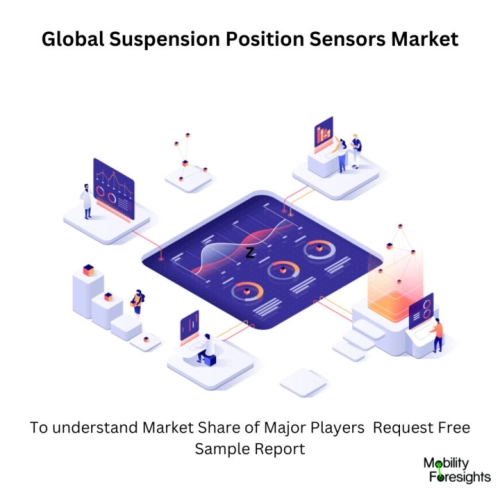
- Get in Touch with Us

Last Updated: Apr 25, 2025 | Study Period: 2023-2030
The sensor tells the self-leveling module to turn on the compressor to adjust the suspension settings by measuring the distance between the road and specific points on the vehicle.
A wide range of sensing technologies can be used to measure linear or rotary position with sensors. There are numerous applications for position sensors; any device that requires movement measurement will make use of one.
In automobiles, sensors are used to determine the positions of the steering wheel, pedals, seats, and various valves, knobs, and actuators.Position sensors come in one of three main categories: linear, rotary, and angular.
A position sensor, also known as a motion sensor, is used to precisely determine the assembly's speed and/or physical position at a particular point in time.After that, this data is sent to a computer, where it will be used for system control or operations control.
The actual position can take a few structures: It could be the system's position in the environment or how it is positioned in relation to an axis (rotation or inclination). Simply calculating this position in relation to time yields the speed.

TheGlobal Suspension position sensors marketaccounted for $XX Billion in 2022 and is anticipated to reach $XX Billion by 2030, registering a CAGR of XX% from 2023 to 2030.
A new Suspension position sensors that is capable of accurately sensing through a variety of solid materials has been developed by Reventec Ltd, a specialist mechanical and electronic product development consultancy.
The AD-015 linear position sensor was initially developed to meet a requirement for long-travel suspension monitoring in motorsports; However, a wide range of other specialist applications in harsh environments already rely on the adaptable technology.
Over a 150mm measurement range, AD-015 accurately detects a magnetic target's position using MagnetoResistive technology.
The sensor, in contrast to the majority of other non-contact position sensing technologies, including common inductive and hall-effect devices, can operate with a variable, large (up to 40 mm) gap between the sensor and the target.
The sensor is one of a kind because it can sense through thick-walled materials like stainless steel, aluminum, titanium, carbon fiber, or a combination of these materials without affecting the measurement accuracy or output of the sensor.
The sensor is suitable for use in harsh environments, such as those with high temperatures, vibration, dust, and moisture, and only weighs 60 grams. It also has a durable aluminum body that is rated IP68.
The sensor is currently available with either an analog 0.5-4.5V CAN or Bluetooth connectivity, which will be available later this year.
In addition to the standard 150mm design, Reventec is able to quickly modify the technology to meet the majority of needs for position sensing with short to long travel.
At the Performance Racing Industry trade show in Indianapolis, the AD-015 position sensor was recently demonstrated, sparking a lot of interest in the technology.
Reventec is currently in talks with a number of customers in the top-level motorsport, industrial, and aerospace industries, where it is extremely desirable that the product be used in harsh environments.
| Sl no | Topic |
| 1 | Market Segmentation |
| 2 | Scope of the report |
| 3 | Abbreviations |
| 4 | Research Methodology |
| 5 | Executive Summary |
| 6 | Introduction |
| 7 | Insights from Industry stakeholders |
| 8 | Cost breakdown of Product by sub-components and average profit margin |
| 9 | Disruptive innovation in the Industry |
| 10 | Technology trends in the Industry |
| 11 | Consumer trends in the industry |
| 12 | Recent Production Milestones |
| 13 | Component Manufacturing in US, EU and China |
| 14 | COVID-19 impact on overall market |
| 15 | COVID-19 impact on Production of components |
| 16 | COVID-19 impact on Point of sale |
| 17 | Market Segmentation, Dynamics and Forecast by Geography, 2023-2030 |
| 18 | Market Segmentation, Dynamics and Forecast by Product Type, 2023-2030 |
| 19 | Market Segmentation, Dynamics and Forecast by Application, 2023-2030 |
| 20 | Market Segmentation, Dynamics and Forecast by End use, 2023-2030 |
| 21 | Product installation rate by OEM, 2023 |
| 22 | Incline/Decline in Average B-2-B selling price in past 5 years |
| 23 | Competition from substitute products |
| 24 | Gross margin and average profitability of suppliers |
| 25 | New product development in past 12 months |
| 26 | M&A in past 12 months |
| 27 | Growth strategy of leading players |
| 28 | Market share of vendors, 2023 |
| 29 | Company Profiles |
| 30 | Unmet needs and opportunity for new suppliers |
| 31 | Conclusion |
| 32 | Appendix |